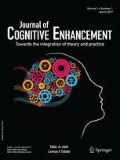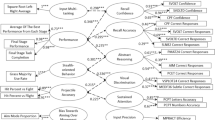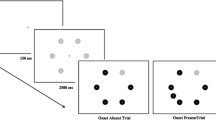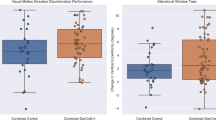Abstract
Over the past 15 years, numerous studies have demonstrated that action video game players outperform non-gamers on a variety of cognitive measures. However, few researchers have examined the potential beneficial effects of playing real-time strategy games or the effect of playing multiple game genres. As such, the purpose of the current study was to (a) replicate the existing findings that show cognitive differences between action gamers (AVGPs) and non-gamers (NVGPs), (b) examine whether real-time strategy gamers (SVGPs) also differ from NVGPs on various cognitive tasks, and (c) examine how multi-genre video game players (“Tweeners”) compare to both AVGPs and NVGPs. We created a large task battery that tapped into various aspects of cognition (i.e., reaction time, selective attention, memory, executive control, and fluid intelligence) in order to examine the tasks that differed between our three gamer groups and non-gamers. Our results largely replicated the majority of the findings to date, such that AVGPs outperformed NVGPs on a wide variety of cognitive tasks, but the two groups do not differ in memory performance or fluid intelligence. We also demonstrated that SVGPs had numerically faster response times on several tasks as compared to the NVGPs. This pattern of results was similar to what was found with the AVGPs, although in the case of the SVGPs not all of the results reached the level of statistical significance. Lastly, we demonstrated that Tweeners perform similarly to genre-pure gamers in that their performance on several cognitive tasks was numerically better than for NVGPs, although the performance of the Tweeners was numerically lower than for both the AVGPs and the SVGPs. Overall, these findings have several implications for game studies, particularly with respect to how SVGPs and Tweeners are considered going forward.






Similar content being viewed by others
References
Adams, D. M., & Mayer, R. E. (2012). Examining the connection between dynamic and static spatial skills and video game performance. Building Bridges Across Cognitive Sciences Around the World: Proceedings of the 34th Annual Meeting of the Cognitive Science Society (CogSci 2012), (1), 1254–1259.
Appelbaum, L. G., Cain, M. S., Darling, E. F., & Mitroff, S. R. (2013). Action video game playing is associated with improved visual sensitivity, but not alterations in visual sensory memory. Attention, Perception, & Psychophysics, 75(6), 1161–1167. doi:10.3758/s13414-013-0472-7.
Apperley, T. H. (2006). Genre and game studies: toward a critical approach to video game genres. Simulation & Gaming, 37(1), 6–23. doi:10.1177/1046878105282278.
Ball, K., & Owsley, C. (1993). The useful field of view test: a new technique for evaluating age-related declines in visual function. Journal of the American Optometric Association, 64(1), 71–79.
Basak, C., Boot, W. R., Voss, M. W., & Kramer, A. F. (2008). Can training in a real-time strategy video game attenuate cognitive decline in older adults? Psychology and Aging, 23(4), 765–777. doi:10.1037/a0013494.
Bavelier, D., Green, C. S., Pouget, A., & Schrater, P. (2012). Brain plasticity through the life span : Learning to learn and action video games. Annual Review of Neuroscience, 35, 391–416. doi:10.1146/annurev-neuro-060909.
Bediou, B., Adams, D. M., Mayer, R. E., Green, C.S, & Bavelier, D. (under review). Meta-analysis of action video game impact on perceptual, attentional, and cognitive skills. Psychological Bulletin.
Boot, W. R., Kramer, A. F., Simons, D. J., Fabiani, M., & Gratton, G. (2008). The effects of video game playing on attention, memory, and executive control. Acta Psychologica, 129(3), 387–398. doi:10.1016/j.actpsy.2008.09.005.
Boot, W. R., Blakely, D. P., & Simons, D. J. (2011). Do action video games improve perception and cognition? Frontiers in Psychology, 2, 226. doi:10.3389/fpsyg.2011.00226.
Boot, W. R., Simons, D. J., Stothart, C., & Stutts, C. (2013). The pervasive problem with placebos in psychology why active control groups are not sufficient to rule out placebo effects. Perspectives on Psychological Science, 8(4), 445–454. doi:10.1177/1745691613491271.
Brainard, D. (1997). The psychophysics toolbox. Spatial Vision, 433–436. doi:10.1163/156856897X00357
Castel, A. D., Pratt, J., & Drummond, E. (2005). The effects of action video game experience on the time course of inhibition of return and the efficiency of visual search. Acta Psychologica, 119(2), 217–230. doi:10.1016/j.actpsy.2005.02.004.
Colzato, L. S., van Leeuwen, P. J. A., van den Wildenberg, W. P. M., & Hommel, B. (2010). DOOM’d to switch: superior cognitive flexibility in players of first person shooter games. Frontiers in Psychology, 1(April), 8. doi:10.3389/fpsyg.2010.00008
Colzato, L. S., van den Wildenberg, W. P. M., & Hommel, B. (2013a). Cognitive control and the COMT Val(158)Met polymorphism: genetic modulation of videogame training and transfer to task-switching efficiency. Psychological Research, 78(5), 670–678. doi:10.1007/s00426-013-0514-8.
Colzato, L. S., van den Wildenberg, W. P. M., Zmigrod, S., & Hommel, B. (2013b). Action video gaming and cognitive control: playing first person shooter games is associated with improvement in working memory but not action inhibition. Psychological Research, 77(2), 234–239. doi:10.1007/s00426-012-0415-2.
Dorval, M., & Pepin, M. (1986). Effect of playing a video game on a measure of spatial visualization. Perceptual Motor Skills, 62, 159–162.
Dye, M. W. G., Green, C. S., & Bavelier, D. (2009a). Increasing speed of processing with action video games. Current Directions in Psychological Science, 18(6), 321–326. doi:10.1111/j.1467-8721.2009.01660.x.
Dye, M. W. G., Green, C. S., & Bavelier, D. (2009b). The development of attention skills in action video game players. Neuropsychologia, 47(8–9), 1780–1789. doi:10.1016/j.neuropsychologia.2009.02.002.
Feng, J., Spence, I., & Pratt, J. (2007). Playing an action video game reduces gender differences in spatial cognition. Psychological Science, 18(10), 850–855. doi:10.1111/j.1467-9280.2007.01990.x.
Gagnon, D. (1985). Videogames and spatial skills: An exploratory study. ECTJ, 33(4), 263–275. doi:10.1007/BF02769363.
Glass, B. D., Maddox, W. T., & Love, B. C. (2013). Real-time strategy game training: Emergence of a cognitive flexibility trait. PloS One, 8(8), e70350. doi:10.1371/journal.pone.0070350.
Green, C. S., & Bavelier, D. (2003). Action video game modifies visual selective attention. Nature, 423(6939), 534–537. doi:10.1038/nature01647.
Green, C. S., & Bavelier, D. (2006). Enumeration versus multiple object tracking: the case of action video game players. Cognition, 101(1), 217–245. doi:10.1016/j.cognition.2005.10.004.
Green, C. S., & Bavelier, D. (2007). Action-video-game experience alters the spatial resolution of vision. Psychological Science, 18(1), 88–94. doi:10.1111/j.1467-9280.2007.01853.x.
Green, C. S., & Bavelier, D. (2008). Exercising your brain: a review of human brain plasticitiy and training-induced learning. Psychology and Aging, 23(4), 692–701. doi:10.1037/a0014345.
Green, C. S., & Bavelier, D. (2015). Action video game training for cognitive enhancement. Current Opinion in Behavioral Sciences, 4, 103–108. doi:10.1016/j.cobeha.2015.04.012.
Green, C. S., Sugarman, M. A., Medford, K., Klobusicky, E., & Bavelier, D. (2012). The effect of action video game experience on task-switching. Computers in Human Behavior, 28(3), 984–994. doi:10.1016/j.chb.2011.12.020.
Green, C. S., Kattner, F., Eichenbaum, A., Bediou, B., Adams, D. M., Mayer, R. E., & Bavelier, D. (2017). Playing some video games but not others is related to cognitive abilities—a critique of Unsworth et al. (2015). Psychological Science.
Greenberg, L. M., Kindschi, C. L., Dupuy, T. R., & Hughes, S. J. (1994). Test of variables of attention continuous performance test. Los Alamitos: Universal Attention Disorders.
Greenfield, P. M. (2014). Mind and media: the effects of television, video games, and computers. Psychology Press.
Greenfield, P. M., Brannon, C., & Lohr, D. (1994a). Two-dimensional representation of movement through three-dimensional space: the role of video game expertise. Journal of Applied Developmental Psychology, 15(1), 87–103. doi:10.1016/0193-3973(94)90007-8.
Greenfield, P. M., DeWinstanley, P., Kilpatrick, H., & Kaye, D. (1994b). Action video games and informal education: effects on strategies for dividing visual attention. Journal of Applied Developmental Psychology, 15(1), 105–123. doi:10.1016/0193-3973(94)90008-6.
Griffith, J. L., Voloschin, P., Gibb, G. D., & Bailey, J. R. (1983). Differences in eye-hand motor coordination of video-game users and non-users. Perceptual and Motor Skills, 57, 155–158. doi:10.2466/pms.1983.57.1.155.
Hull, D. C., Williams, G. a., & Griffiths, M. D. (2013). Video game characteristics, happiness and flow as predictors of addiction among video game players: a pilot study. Journal of Behavioral Addictions, 2(3), 145–152. doi:10.1556/JBA.2.2013.005.
Jaeggi, S. M., Buschkuehl, M., Jonides, J., & Perrig, W. J. (2008). Improving fluid intelligence with training on working memory. Proceedings of the National Academy of Sciences of the United States of America, 105(19), 6829–6833. doi:10.1073/pnas.0801268105.
Jarosz, A. F., & Wiley, J. (2014). What are the odds? A practical guide to computing and reporting Bayes factors. The Journal of Problem Solving, 7, 2–9. doi:10.7771/1932-6246.1167.
Karle, J. W., Watter, S., & Shedden, J. M. (2010). Task switching in video game players: benefits of selective attention but not resistance to proactive interference. Acta Psychologica, 134(1), 70–78. doi:10.1016/j.actpsy.2009.12.007.
King, D., Delfabbro, P., & Griffiths, M. (2010). Video game structural characteristics: a new psychological taxonomy. International Journal of Mental Health and Addiction, 8(1), 90–106. doi:10.1007/s11469-009-9206-4.
Kirchner, W. K. (1958). Age differences in short-term retention of rapidly changing information. Journal of Experimental Psychology, 55(4), 352. doi:10.1037/h0043688.
Kleiner, M., Brainard, D., Pelli, D., Ingling, A., Murray, R., & Broussard, C. (2007). What’s new in Psychtoolbox-3. Perception, 36(14), 1.
Love, J., Selker, R., Verhagen, J., Marsman, M., Gronau, Q. F., Jamil, T., Smira, M., Epskamp, S., Wild, A., Morey, R., Rouder, J. & Wagenmakers, E. J. (2015). JASP (Version 0.6)[Computer software].
McDermott, A. F., Bavelier, D., & Green, C. S. (2014). Memory abilities in action video game players. Computers in Human Behavior, 34, 69–78. doi:10.1016/j.chb.2014.01.018.
Morey, R. D., & Rouder, J. N. (2011). Bayes factor approaches for testing interval null hypotheses. Psychological Methods, 16(4), 406–419. doi:10.1037/a0024377.
Oei, A. C., & Patterson, M. D. (2013). Enhancing cognition with video games: a multiple game training study. PloS One, 8(3), e58546. doi:10.1371/journal.pone.0058546.
Okagaki, L., & Frensch, P. A. (1994). Effects of video game playing on measures of spatial performance: gender effects in late adolescence. Journal of Applied Developmental Psychology, 15(1), 33–58. doi:10.1016/0193-3973(94)90005-1.
Pelli, D. G. (1997). The VideoToolbox software for visual psychophysics: transforming numbers into movies. Spatial Vision, 10(4), 437–442. doi:10.1163/156856897X00366.
Raven, J. (2000). The Raven’s Progressive Matrices: change and stability over culture and time. Cognitive Psychology, 41(1), 1–48. doi:10.1006/cogp.1999.0735.
Raymond, J. E., Shapiro, K. L., & Arnell, K. M. (1992). Temporary suppression of visual processing in an RSVP task: an attentional blink? Journal of Experimental Psychology: Human Perception and Performance, 18(3), 849–860. doi:10.1037/0096-1523.18.3.849.
Redick, T. S., Shipstead, Z., Harrison, T. L., Hicks, K. L., Fried, D. E., Hambrick, D. Z., … Engle, R. W. (2013). No evidence of intelligence improvement after working memory training: a randomized, placebo-controlled study. Journal of Experimental Psychology. General, 142(2), 359–79. doi:10.1037/a0029082
Rouder, J. N., Speckman, P. L., Sun, D., Morey, R. D., & Iverson, G. (2009). Bayesian t tests for accepting and rejecting the null hypothesis. Psychonomic Bulletin & Review, 16(2), 225–237. doi:10.3758/PBR.16.2.225.
Spence, I., & Feng, J. (2010). Video games and spatial cognition. Review of General Psychology, 14(2), 92–104. doi:10.1037/a0019491.
Strobach, T., Frensch, P. A., & Schubert, T. (2012). Video game practice optimizes executive control skills in dual-task and task switching situations. Acta Psychologica, 140(1), 13–24. doi:10.1016/j.actpsy.2012.02.001.
Subrahmanyam, K., & Greenfield, P. M. (1994). Effect of video game practice on spatial skills in girls and boys. Journal of Applied Developmental Psychology, 15, 13–32. doi:10.1016/0193-3973(94)90004-3.
Turner, M. L., & Engle, R. W. (1989). Is working memory capacity task dependent? Journal of Memory and Language, 28(2), 127–154. doi:10.1016/0749-596X(89)90040-5.
Wood, R. T. A., Griffiths, M. D., Chappell, D., & Davies, M. N. O. (2004). The structural characteristics of video games: a psycho-structural analysis. Cyberpsychology and Behavior, 7(1), 1–10. doi:10.1089/109493104322820057.
Yung, A., Cardoso-Leite, P., Dale, G., Bavelier, D., & Green, C. S. (2015). Methods to test visual attention online. Journal of Visualized Experiments, 96, 1–15. doi:10.1016/bs.mcb.2015.01.016.
Author information
Authors and Affiliations
Corresponding author
Additional information
This research was supported by a grant from the Office of Naval Research N00014-14-1-0512 to C.S.G.
Electronic supplementary material
ESM 1
(DOCX 27 kb)
Rights and permissions
About this article
Cite this article
Dale, G., Green, C.S. Associations Between Avid Action and Real-Time Strategy Game Play and Cognitive Performance: a Pilot Study. J Cogn Enhanc 1, 295–317 (2017). https://doi.org/10.1007/s41465-017-0021-8
Received:
Accepted:
Published:
Issue Date:
DOI: https://doi.org/10.1007/s41465-017-0021-8




